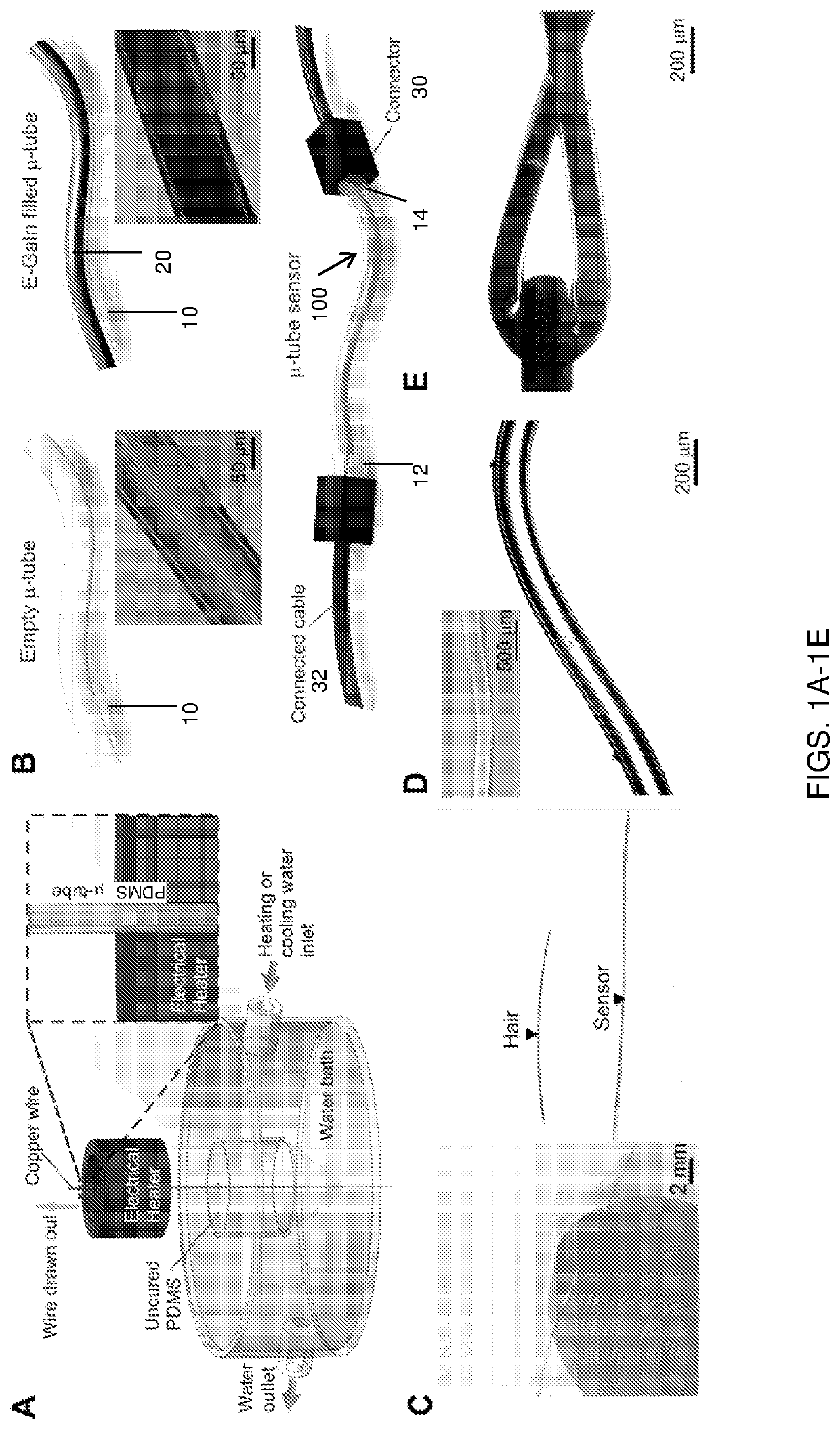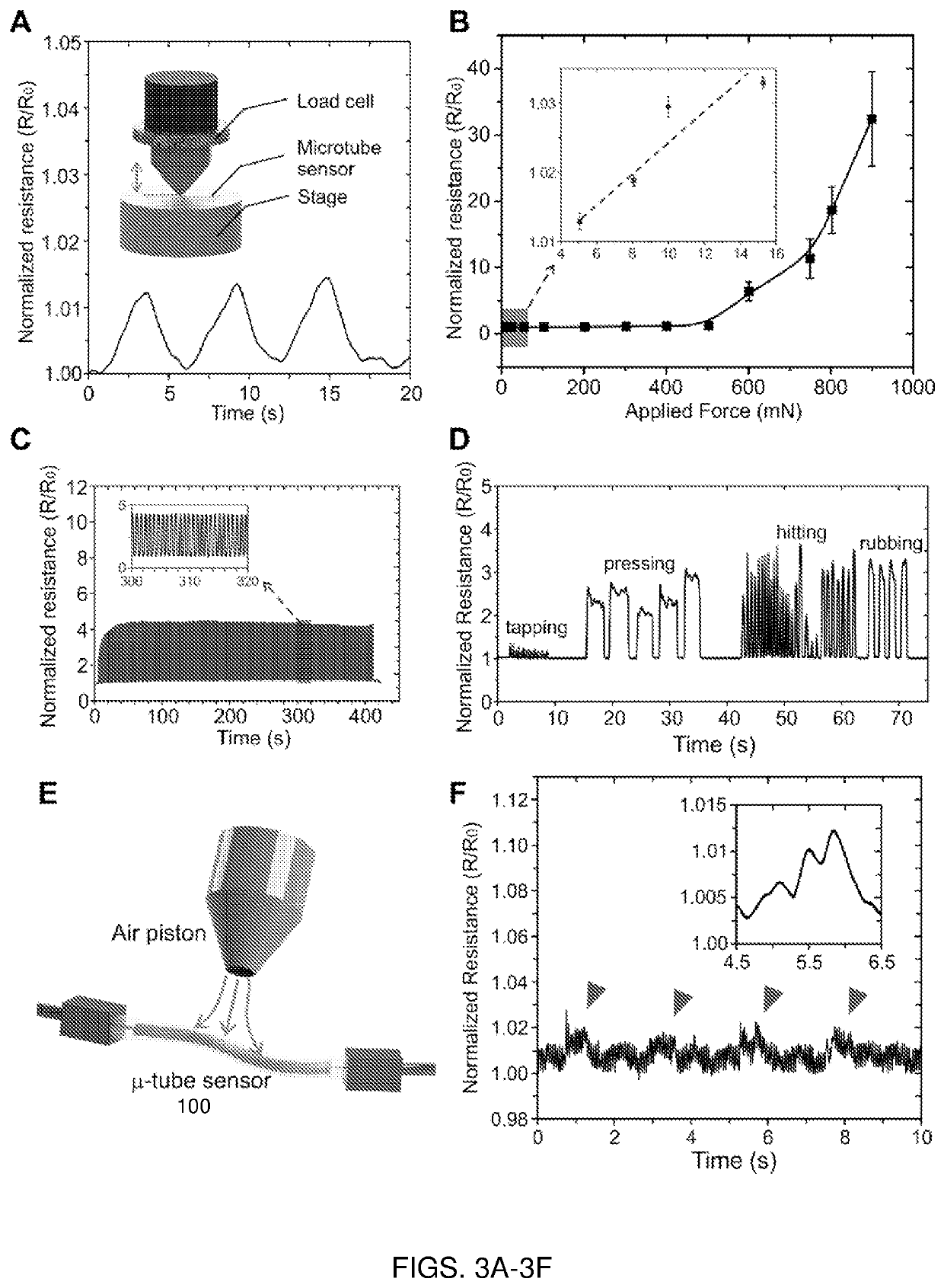Microtube Sensor For Physiological Monitoring
a physiological monitoring and microtube technology, applied in the direction of angiography, force measurement by measuring optical property variation, instruments, etc., can solve the problems of increasing the wearability of the sensor for the user, reducing the electronics components, and not being able to achieve the planar substrate effect, etc., to achieve the effect of improving compliance and comfort, reducing electronics components, and high sensitivity
- Summary
- Abstract
- Description
- Claims
- Application Information
AI Technical Summary
Benefits of technology
Problems solved by technology
Method used
Image
Examples
example 1
ement Analysis
[0088]Finite element modeling of the microtube tactile sensors was performed using ABAQUS CAE for both 2D plane strain and 3D analyses, depending on the geometry of the top pitch (i.e., the crosshead compressing the microtube). Due to symmetry, half and quarter models were established for 2D plane strain and 3D analyses, respectively. General static analysis mode was selected with hard and frictionless contact established between the top pitch and the top half outer surface of the microtube, bottom plate and lower half outer surface of the microtube, as well as the microtube inner surface. Hybrid and linear elements with reduced integration were used for contact analysis. The tube wall was divided into 6 layers in the large stress regions near the mid-plane, and 4 layers in the other regions. Flexible polydimethylsiloxane (PDMS) was assumed to be elastic,[10] and Poisson's ratio was chosen to be 0.49.
example 2
sign and Fabrication
[0089]To create the microtube, a metal filament (e.g., wire) was first immersed vertically into a freshly mixed PDMS base and curing agent, 10:1 (w / w) (e.g., mixture of Sylgard 184 silicone elastomer base and Sylgard 184 silicone elastomer curing agent, 10:1 by weight). The metal filament was drawn out of the PDMS pool using a rotary motor at a velocity of 2 to 4 mm / s. Simultaneously, hot water of ˜100° C. was added to the surrounding PDMS pool to initiate PDMS curing. When the metal wire was drawn out vertically above the liquid level, it was further cured by hot air at ˜95° C. in a cylindrical heating unit. To maintain the optimal viscosity of the PDMS for even coating around the metal filament, cold water would be added into the PDMS pool surroundings to prolong curing time. Next, the metal wire was peeled off during a sonication process in acetone solution which would wash off unreacted elastomer curing agent and caused slight swelling in the polymer—loosenin...
example 3
Sensing, Durability and Mechanical Forces Differentiation
[0090]The liquid-based microtube tactile sensor was subjected to compressive ramp-hold-release loads starting from 10 mN to 100 mN using a universal load machine (5848 MicroTester, Instron, Norwood, Mass.), as schematically illustrated in FIG. 3A. The ramp and release rates were set at 5 mm / min. The electrical response of the tactile sensor upon different load applications was continuously monitored and recorded using a customized data logging microprocessor at 20 Hz.
PUM
 Login to View More
Login to View More Abstract
Description
Claims
Application Information
 Login to View More
Login to View More - R&D
- Intellectual Property
- Life Sciences
- Materials
- Tech Scout
- Unparalleled Data Quality
- Higher Quality Content
- 60% Fewer Hallucinations
Browse by: Latest US Patents, China's latest patents, Technical Efficacy Thesaurus, Application Domain, Technology Topic, Popular Technical Reports.
© 2025 PatSnap. All rights reserved.Legal|Privacy policy|Modern Slavery Act Transparency Statement|Sitemap|About US| Contact US: help@patsnap.com



